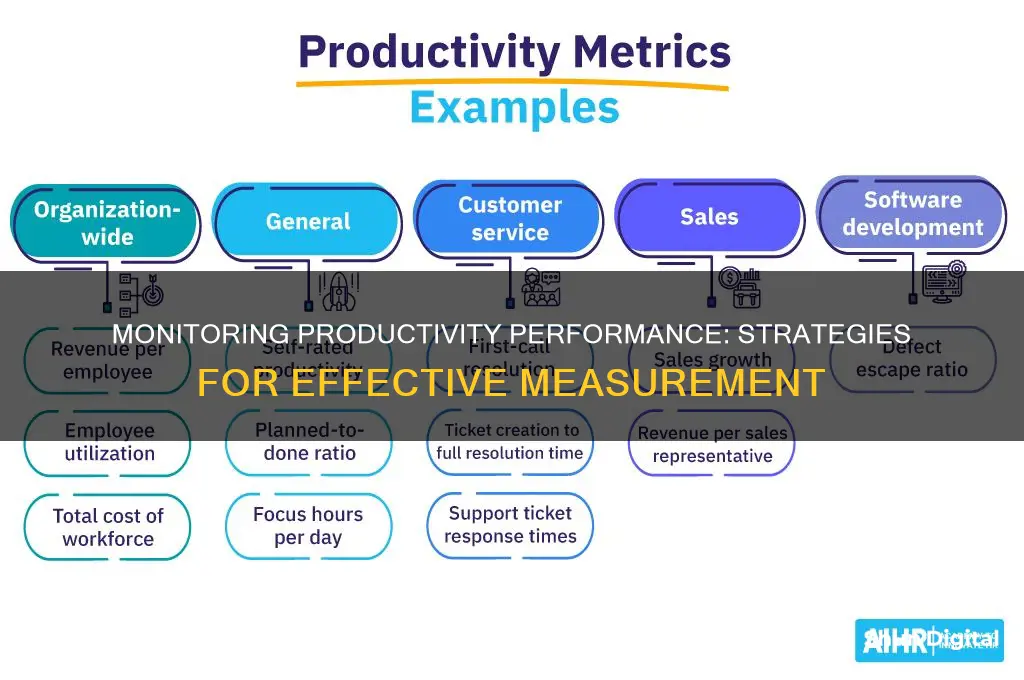
Monitoring employee productivity is a complex task that requires a careful balance between maintaining excellent performance and respecting employees' well-being and privacy. With the digitalization of work and the rise of hybrid and remote work practices, organizations have shown increased interest in tracking workplace productivity. However, it is essential to implement such practices with proper communication and transparency to avoid creating a toxic work environment. This paragraph will discuss the benefits, challenges, and ethical considerations of monitoring productivity performance, as well as provide tips for doing so effectively and respectfully.
| Characteristics | Values |
|---|---|
| Productivity tracking software | CurrentWare, ActivTrak, BrowseReporter, Asana, Monday, Trello, etc. |
| Qualitative methods | Employee surveys on workload and satisfaction, peer feedback on collaboration and teamwork, observation of work habits and processes |
| Quantitative methods | Number of tasks completed, time spent on specific activities, revenue generated per employee, customer satisfaction ratings |
| Key Performance Indicators (KPIs) | Capacity Utilisation Rate, Revenue Per Employee |
| Goals | Clear, measurable, and actionable |
| Communication | Open communication and transparency with employees about the software |
| Employee well-being | Prioritize employee well-being, ensure breaks, encourage healthy work-life balance, and emphasize quality work over constant activity |
| Data protection | Ensure data security and confidentiality |
What You'll Learn

Define appropriate metrics
When defining appropriate metrics for monitoring productivity, it is important to consider the goals and values of the company. This ensures that the metrics are aligned with the organisation's objectives and that employee monitoring is not excessive or intrusive.
Firstly, it is important to recognise that productivity is not solely about labour or wages, but is the output divided by the input. Therefore, it is important to identify the contribution of each factor in production and gain an understanding of productivity trends. For example, time spent on tasks is a common metric used to measure productivity, but this does not always indicate an employee's performance.
When defining metrics, it is important to consider the industry and role. For example, a salesperson's productivity can be measured by sales figures, whereas a designer's productivity might focus on the quality and speed of design iterations. It is also important to consider the company's goals and ensure that the productivity metrics align with the overall business objectives.
- Time spent on work: Tracking employee hours helps to ensure employees are working the hours for which they are paid, calculate accurate compensation rates, and keep track of overtime. It also helps management analyse work habits and identify areas for improvement.
- Ability to meet deadlines and estimates: Monitoring project deadlines and estimates helps to set achievable goals, maintain project timelines, and increase the chances of project success.
- Absenteeism: Tracking unplanned absences helps to identify underlying issues, ensure effective staffing and workload management, and prevent disruptions to the established workflow.
- Revenue per employee: This is a quantifiable measure that can be used to compare changes in performance over time.
- Customer satisfaction ratings: In client-facing roles, customer satisfaction surveys can provide valuable insights into the impact of an employee's work.
When defining appropriate metrics, it is also crucial to communicate the monitoring process clearly to employees. This includes explaining the reasons for monitoring, the data being collected, and how the data will be used and protected. Obtaining employee consent and establishing clear boundaries for monitoring are essential for maintaining trust and avoiding legal issues.
Best Monitors to Pair with a 1660 Ti Graphics Card
You may want to see also

Establish clear and transparent policies
Establishing clear and transparent policies is an essential step in monitoring employee productivity. Here are some key points to consider when creating such policies:
Start with clear objectives
The first step is to define the reasons for monitoring employee productivity. Are you aiming to protect against data breaches, improve productivity, or ensure compliance with company policies and performance standards? Outline these objectives clearly in your policy document.
Communicate the policy to employees
Provide all team members with a written copy of the policy and encourage them to ask questions. Transparency is key to building trust and ensuring employees understand the reasons behind the monitoring.
Define the scope of monitoring
Be explicit about the activities that will be monitored and the methods used. Explain how the monitoring will be carried out and any limitations to the approach. For example, will you be tracking website usage, keyboard activity, or video feeds? Be sure to address any concerns about privacy and reassure employees that their personal information will be protected.
Obtain employee consent
Stealthy surveillance is never a good idea. Be open and honest with your employees about the monitoring. Let them know that their activities will be tracked and their data will be collected and analysed. This builds trust and reduces resistance or resentment towards the practice.
Focus on respect and privacy
Reassure employees that their privacy rights will be respected. Only collect the data necessary for your defined objectives and do not share it with third parties unless explicitly permitted by the employees and required by law. Be mindful of relevant privacy laws and obtain employee consent for the monitoring.
Provide regular feedback
Link the monitoring process to employee development and growth by providing regular feedback. Set clear performance indicators and communicate them to all employees. This helps employees understand their strengths and weaknesses and provides a motivation boost.
Offer support and training
If you identify underperforming employees, offer guidance and training to help them improve. This demonstrates your commitment to their growth and development, which can lead to increased productivity and overall organisational success.
Best Places to Find High Refresh Rate Monitors
You may want to see also

Focus on rewards, not punishment
When monitoring employee productivity, it's important to focus on rewards and recognition rather than punishment. This approach boosts employee morale, engagement, and motivation, leading to increased productivity. Here are some strategies to implement this approach effectively:
Understand the Value of Rewards and Recognition
Recognizing employees for their work is crucial for several reasons. Firstly, it addresses the intrinsic needs of employees for autonomy, increasing responsibility, and a sense of accomplishment. Secondly, it makes employees feel valued and appreciated, leading to higher job satisfaction and retention. Additionally, it helps to build a positive company culture and strengthens the relationship between employees and the organization.
Set Clear Goals and Expectations
It is important to set clear, measurable, and achievable goals for your employees. This provides them with a sense of direction and helps them understand what is expected of them. Ensure that the goals are aligned with the company's overall mission, strategy, and goals. This way, employees can see how their individual contributions make a difference.
Offer a Variety of Rewards
When designing a rewards program, offer a variety of unique and valuable rewards that appeal to your specific workforce. Go beyond financial incentives and consider other forms of recognition such as public praise, role advancement, project ownership, or personalized rewards such as handwritten notes. You can also offer scheduling freedom or social events to show your appreciation.
Recognize Both Big and Small Achievements
Don't just focus on major accomplishments. Celebrate the small wins along the way to keep morale high and show that you value the progress and effort put in by your employees. This will lead to increased engagement and motivation.
Provide Regular Feedback
Frequent feedback helps employees stay on track and feel more comfortable with the process. It also helps to identify areas where they may need improvement or additional support. Regular feedback can be in the form of one-on-one meetings, performance reviews, or through the use of employee productivity monitoring software.
Prioritize Employee Well-being
Ensure that your focus on productivity does not come at the cost of employee well-being. Encourage healthy work-life balance, provide breaks, and emphasize the importance of quality work over constant activity. Overworking employees can lead to decreased productivity and increased turnover.
By implementing these strategies, you can create a culture of recognition and reward that motivates your employees and drives them to reach their full potential. Remember, the goal is not just to monitor productivity but also to create an environment that fosters growth, engagement, and satisfaction for your employees.
Ankle Monitor: McCain's Uncomfortable Truth
You may want to see also

Consider individual circumstances
When monitoring productivity performance, it is important to consider individual circumstances. Productivity means different things for different people and roles. For example, a builder's productivity could be measured by how much they build or how quickly they complete projects, whereas a writer might focus on their word count.
It is also important to note that productivity is not the only indicator of individual or organisational performance. It interacts with other aspects of employee performance, financial controls, innovation, and competitive effectiveness. When measuring productivity, it is important to define what "being productive" means to you and your organisation. For example, some companies measure productivity by looking at how long employees are active on their computers, but this does not necessarily reflect their accomplishments. A better measurement might be looking at customer interactions or completed sales.
When considering individual circumstances, it is also important to establish reliable metrics. These metrics will likely change depending on the role of the individual. For example, for a sales team, a good metric for measuring productivity could be the number of leads or sales an employee can execute in a week or month. For a cleaning crew, it might be the number of jobs an individual completes in a day.
It is also important to understand productivity baselines. It might take some time to develop baselines for team and individual productivity. It is important to set goals for teams that are ambitious yet attainable. This requires consistent tracking. If you are measuring your own or someone else's productivity, try to find the average of your chosen metrics after a month and consider any outside factors that could affect those numbers.
Finally, when considering individual circumstances, it is important to track how different strategies affect productivity. With consistent tracking, you can discover correlations between management strategies and employee productivity. Try to discover the underlying reasons why productivity might be higher or lower than average. For example, offering a bonus opportunity for employees who meet specific goals might encourage increased production.
In conclusion, when monitoring productivity performance, it is important to consider individual circumstances such as the definition of productivity for different roles, the interaction of productivity with other performance indicators, the establishment of reliable metrics, the understanding of productivity baselines, and the tracking of how different strategies affect productivity.
Eliminating Optimizer Pro Performance Monitor: A Step-by-Step Guide
You may want to see also

Treat everyone equally
While monitoring employee productivity, it is important to treat everyone equally. This does not mean that everyone should be treated the same, but rather that everyone should be treated fairly. Fairness has a strong evolutionary basis and is linked to reciprocal altruism, which is one of the foundations of human societies and the modern human rights system.
- Make the rules clear: Clearly communicate the objectives, performance standards, expected outcomes, and expected behaviour to all employees.
- Aim for fair processes: Use blind testing in recruitment to reduce bias, for example.
- Foster open communication: Create a safe environment where team members can approach management without fear of retaliation and where input and feedback are welcomed.
- Reward results, not effort: Thank employees for their hard work, but do not confuse this with good performance. Counsel employees who are putting in a lot of hours but not producing results, and reward those who are efficient and effective.
- Don't punish the whole team for the mistakes of a few: Address performance issues with the individuals concerned, rather than sending an all-team email or organising a group refresher training.
- Be accountable for outcomes: Take ownership of the team's successes and failures, rather than blaming team members when things go wrong.
By following these suggestions, managers can ensure they are treating their employees fairly and equitably while monitoring productivity performance.
How LCD Monitors Handle Frequency Interference
You may want to see also
Frequently asked questions
Excessive employee monitoring can cause the following issues:
- Loss of trust: Employees may feel anxious and stressed, leading to lower job satisfaction, poor morale, and reduced retention.
- Impaired employee well-being: Increased surveillance affects personal and professional well-being, leading to absenteeism and burnout.
- Breach of privacy: Collecting too much data via monitoring tools may infringe on employees' right to privacy and potentially lead to litigation.
- Loss of creativity: Excessive monitoring discourages experimentation and stifles autonomy and creativity. Employees may feel less comfortable sharing ideas and providing feedback.
- Decreased productivity: Over time, excessive monitoring can demotivate employees, reducing their willingness to take risks and try new things, which negatively impacts performance.
According to a 2019 Deloitte survey, 55% of millennial employees prefer to leave companies that prioritise profit over people. This highlights the importance of balancing productivity measurement with a people-oriented approach. Employee monitoring should be carried out respectfully, upholding privacy and trust, and aligning with ethical values. It should also be communicated clearly to employees, with defined metrics in place to avoid micromanagement.
A:
- Define appropriate metrics: Establish metrics that align with your company's goals and values to maintain accountability without micromanaging.
- Establish clear and transparent policies: Communicate the reasons for monitoring, what will be monitored, and how it will be done. Obtain employee consent and reassure them about their privacy rights.
- Focus on rewards instead of punishment: Link monitoring to employee appreciation and development programs to foster a culture of transparency and trust, positively impacting morale and productivity.
- Consider individual circumstances: Be understanding and flexible towards employees who may be facing personal challenges or difficulties balancing work and other commitments.
- Treat everyone equally: Apply monitoring policies equally to ensure a fair and just system, avoiding charges of discrimination.
- Use unintrusive tools: Invest in tools that respect employees' privacy, allowing them to focus on delivering results without feeling constantly watched.
A:
- Software solutions: Employee productivity monitoring software can track computer activities, active vs. idle time, web browsing, application usage, and provide insights into productivity patterns.
- 1:1 meetings and reports: Regular check-ins can help uncover roadblocks, identify skill gaps, boost morale, track progress, and facilitate better goal-setting.
- Project management tools: Tools like Asana, Monday, and Trello enhance organisation, collaboration, visibility, resource management, and risk management, ultimately boosting team productivity.
- Employee surveys and feedback: These can gauge employee engagement, identify bottlenecks, assess work-life balance, uncover skill gaps, and improve communication and collaboration.







